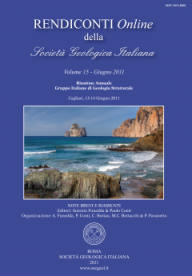
Kilometre-scale strain partitioning of the Mont Morion Permian metaintrusives during Alpine subduction (Dent-Blanche Unit, Valpelline - Western Italian Alps)
Manuel Roda (*) & Michele Zucali (**)
(*) Dipartimento di Scienze della Terra "A. Desio", Sezione di Geofisica, Università degli Studi di Milano, Via L. Cicognara 7, 20129 Milano, Italy. E-mail: manuel.roda@unimi.it
(**) Dipartimento di Scienze della Terra "A. Desio", Sezione di Geologia, Università degli Studi di Milano, Via Mangiagalli 34, 20133 Milano, Italy. E-mail: michele.zucali@unimi.it
Volume: 15/2011
Pages: 117-120
Abstract
The structural and metamorphic evolution of Mont Morion Complex lithotypes, from pre-Permian to present, is presented. We identified pre-Permian rocks (e.g. amphibolite, biotite-bearing gneiss and acid granulite) preserved as roof pendants (i.e. xenoliths) within Permian intrusives. Permian intrusives and xenoliths are re-equilibrated during the Alpine time and coronitic to mylonitic metaintrusives are produced, due to meter to kilometer-scale fabric gradients, with associated white mica-, glaucophane-bearing gneiss. The tectono-metamorphic map shows the traces of the superimposed foliations and the fold axial planes. The foliations are distinguished on the basis of their relative chronology and mineralogical support. Using these structural data, reported on a single map, the successive stages of this portion of the Adria plate can be reconstruct: (i) a pre-Alpine extension, recorded by granulite- to amphibolite-facies xenolits; (ii) the Permian magmatic phase (e.g. Mont Morion, Mont Collon and Matterhorn intrusives); (iii) the Alpine subduction and subsequent collision.
Keywords
Get Full Text